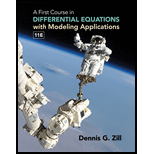
Concept explainers
The ballistic pendulum Historically, in order to maintain quality control over munitions (bullets) produced by an assembly line, the manufacturer would use a ballistic pendulum to determine the muzzle velocity of a gun, that is, the speed of a bullet as it leaves the barrel. Invented in 1742 by the English engineer Benjamin Robins, the ballistic pendulum is simply a plane pendulum consisting of a rod of negligible mass to which a block of wood of mass mw is attached. The system is set in motion by the impact of a bullet which is moving horizontally at the unknown velocity vb; at the time of the impact, which we take as t = 0, the combined mass is mw + mb, where mb is the mass of the bullet imbedded in the wood. In (7) of this section, we saw that in the case of small oscillations, the angular displacement θ(t) of a plane pendulum shown in Figure 5.3.3 is given by the linear DE
Intuitively, the horizontal velocity V of the combined mass (wood plus bullet) after impact is only a fraction of the velocity vb of the bullet, that is,
Now recall, a distance s traveled by a particle moving along a circular path is related to the radius l and central angle θ by the formula s = lθ. By differentiating the last formula with respect to time t, it follows that the angular velocity ω of the mass and its linear velocity v are related by v = lω. Thus the initial angular velocity ω0 at the time t at which the bullet impacts the wood block is related to V by V = lω0 or
- (a) Solve the initial-value problem
- (b) Use the result from part (a) to show that
- (c) Use Figure 5.3.11 to express cos θmax in terms of l and h. Then use the first two terms of the Maclaurin series for cos θ to express θmax in terms of l and h. Finally, show that vb is given (approximately) by
- (d) Use the result in part (c) to find vb and mb = 5 g, mw = 1 kg, and h = 6 cm.

Trending nowThis is a popular solution!

Chapter 5 Solutions
A First Course in Differential Equations with Modeling Applications (MindTap Course List)
- Algebra & Trigonometry with Analytic GeometryAlgebraISBN:9781133382119Author:SwokowskiPublisher:Cengage
